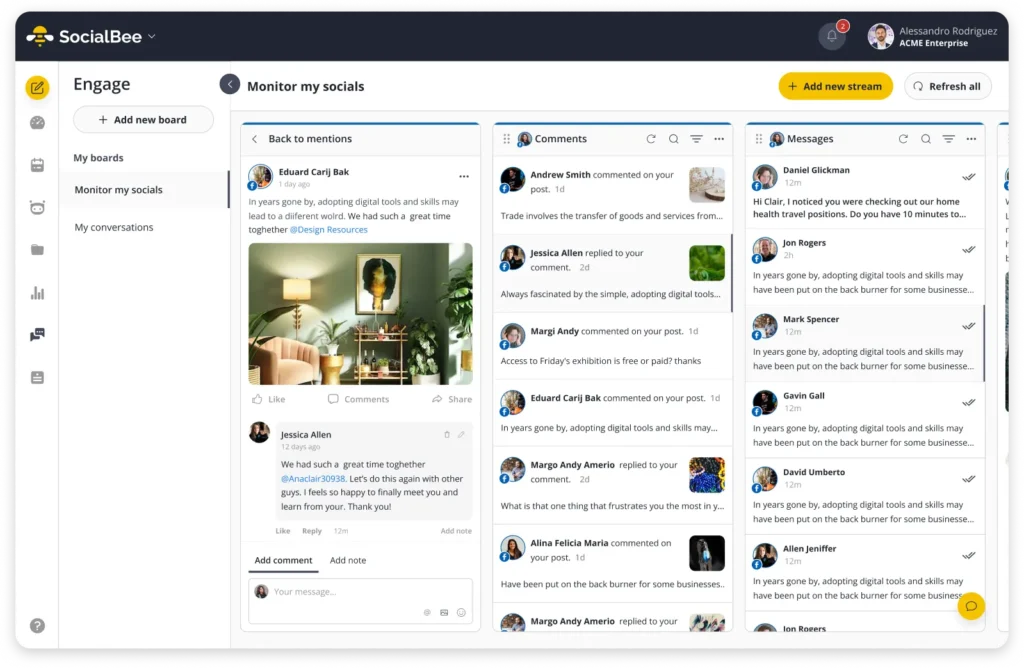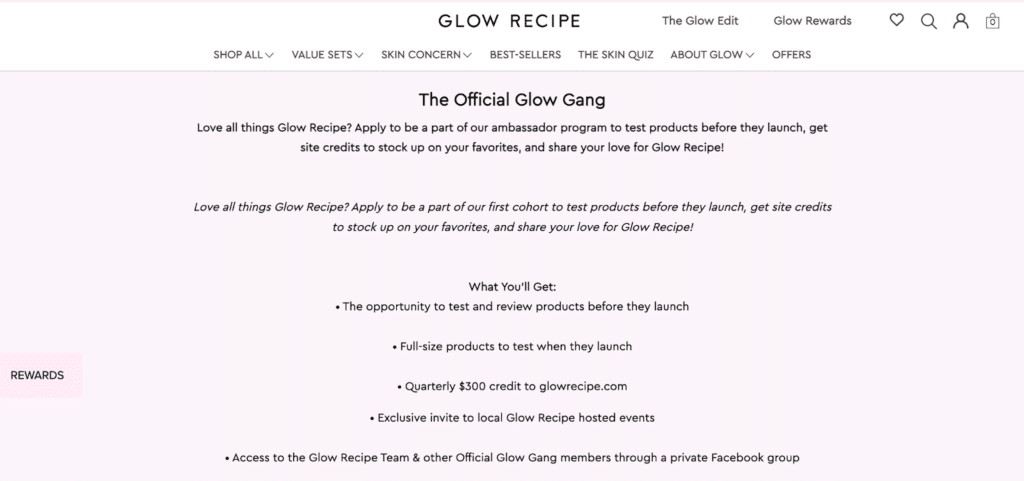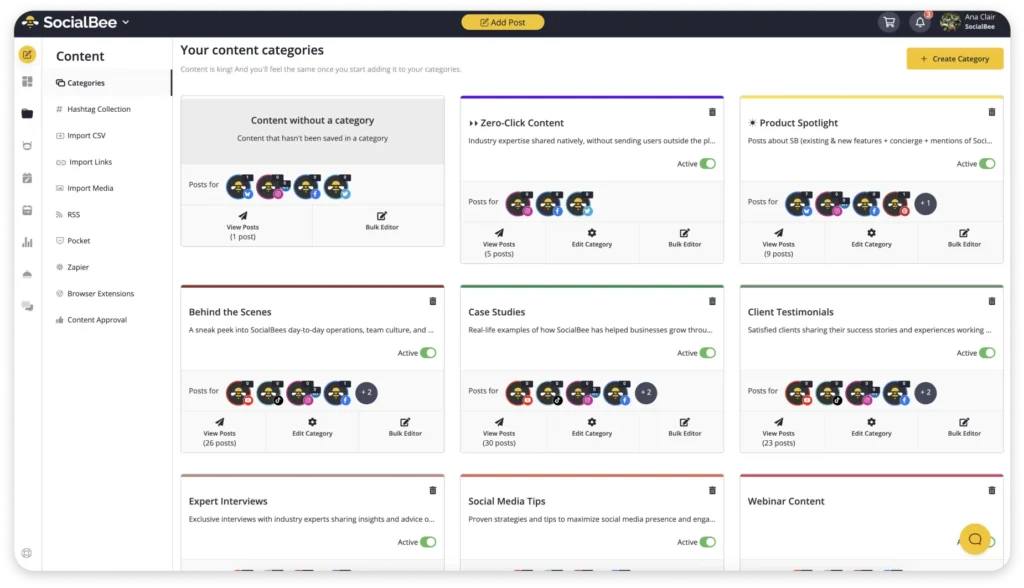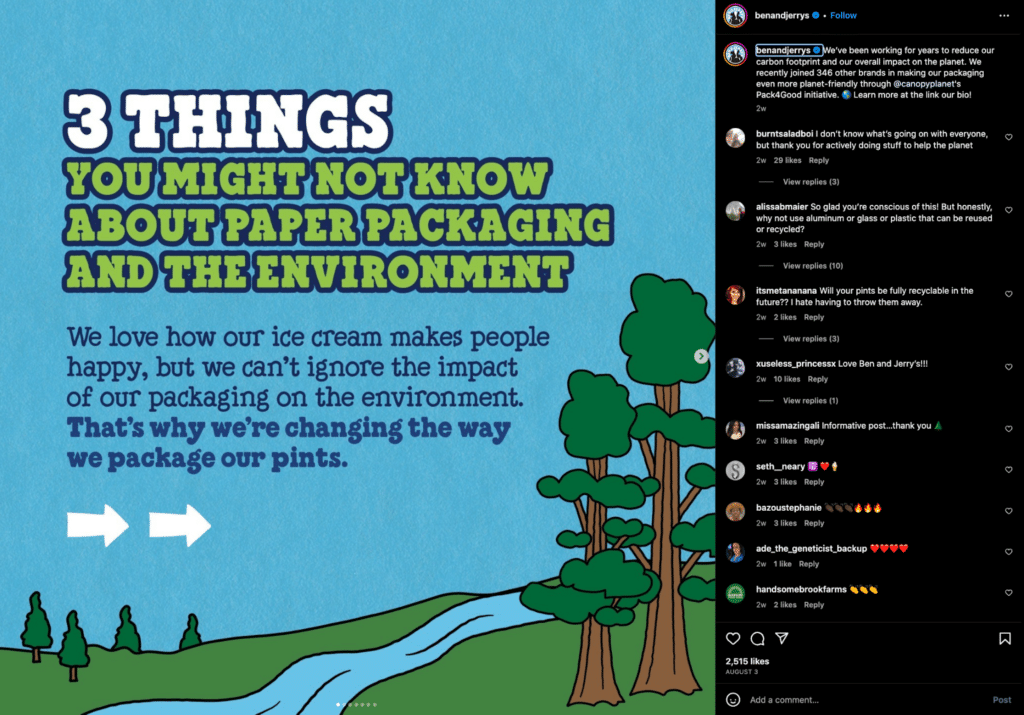
Guest Author
Without brand authenticity, it becomes impossible for businesses to succeed. Think about it: shopping has become incredibly easy thanks to the Internet. Type in what you’re looking for, and you’ll find hundreds of brands selling almost the exact same thing. You can only go so far with competitive pricing.
Plus, today’s consumers seek more than great products — they crave authenticity. With 70% of consumers reporting that authentic brands give them a stronger feeling of confidence, it’s clear that today’s shopper is searching for deeper connections with brands they support.
In this article, we’ll walk you through some of the reasons why brand authenticity matters, and we’ll provide you with the needed information for authentic social media branding. Ready to find out more?
We’re SocialBee LABS SRL, part of WebPros. We use the information you provide to share relevant content and product updates, as outlined in our Privacy Policy. You can opt out anytime.
Short Summary
- In a marketplace flooded with options, a brand’s authenticity makes it memorable, allowing customers to imagine a unique identity that resonates with their personal values. This distinctiveness is critical for differentiation.
- Authenticity fosters trust and loyalty. When customers feel that a brand truly represents something meaningful, they’re more likely to commit long-term, turning into advocates for the brand.
- Authentic brands attract not just customers but also passionate supporters who believe in the brand’s mission. This alignment can propel a brand closer to its success by ensuring a dedicated customer base.
- Today, it’s not enough to offer quality products or services; customers expect brands to take a stand on social, environmental, and political issues, reflecting a brand’s authenticity through action, not just words.
- Authentic storytelling allows a brand to share its journey, challenges, and victories, creating an emotional connection with customers. This narrative approach elevates a brand from merely being a business to being a part of customers’ lives.
- Customers are more likely to support brands that advocate for causes they care about. This shared commitment strengthens the relationship between customers and brands, making the brand’s authenticity a powerful tool for engagement.
- Customers value transparency about product sourcing, business practices, and company values. A transparent approach reinforces a brand’s authenticity, further building customer trust and loyalty.
What Exactly Is “Brand Authenticity”?
Brand authenticity refers to a brand’s efforts to be true to its messaging and values. An authentic brand is always transparent, honest with its customers, and faithful to its promises.
For example, if one of your marketing messages includes being a sustainable brand, this must translate into all your practices, not just in environmental efforts for your products. Having environmentally sustainable products doesn’t mean anything if they’re produced in a way that violates workers’ rights.
Honesty plays a huge role in being an authentic brand. However, there’s more to being authentic than being genuine in your marketing promises. Today’s consumers expect brands to take a stand and care about the same issues they care about.
An authentic brand is a brand with integrity. Your customers know that every brand is a money-making business, so they should support those who deserve it.
Why Is Being an Authentic Brand So Important?
We live in a world of misinformation, and today’s consumers have lost confidence in businesses. According to Gallup’s annual survey on America’s confidence in institutions, only 5% of people trust big businesses, while 42% say they have very little trust.
Here are some of the reasons why brand authenticity matters:
- Shapes brand image: A brand’s authenticity is pivotal in shaping its image. It influences how customers imagine the brand, forming a mental picture that aligns with the brand’s true values and mission. This genuine representation helps in building a strong and positive brand identity.
- Differentiates: Authenticity helps a brand stand out in a crowded market. In a cluttered market where consumers are flooded with choices, a solid branding strategy can set your business apart. It goes beyond mere logos and mottos; it delves into the essence of what your brand stands for and how it communicates with its audience. Crafting an authentic branding strategy ensures that your consumers see through the clutter and connect with what truly matters—your values, mission, and promise. In an era where consumers are bombarded with countless choices, a brand that remains true to its essence can distinguish itself more effectively, attracting customers who value authenticity and transparency.
- Builds customer trust: When a brand consistently demonstrates authenticity, customers feel a deeper sense of trust. This trust is built on the understanding that the brand is not just chasing profit but is genuinely interested in delivering value and upholding its promises.
- Enhances customer loyalty: Authenticity fosters an emotional connection between the brand and its customers. When customers feel that a brand is authentic, they are more likely to develop loyalty, becoming not just repeat buyers but also brand advocates among peers.
- Encourages engagement: An authentic brand encourages more meaningful engagement from its customers. People are more likely to interact, provide feedback, and participate in a community surrounding a brand when they feel it represents genuine values and practices.
- Supports brand consistency: Maintaining a brand’s authenticity requires consistency in messaging, actions, and values. This consistency reinforces the brand’s identity over time, making it easier for customers to recognize and support the brand across different platforms and interactions.
These elements combined contribute significantly to a brand’s success and its ability to make customers feel valued and understood.
How to Build Brand Authenticity in the Digital Age
Your customers are bombarded with all kinds of marketing material wherever they go.
You need to cut through the noise. In fact, 90% of millennials consider authenticity a significant factor when choosing a brand to support, with 30% saying they have unfollowed a brand because of “inauthentic” content.
Here are the steps you need to take in the process of building brand authenticity:
- Build your brand story
- Leverage social media to build a loyal community
- Introduce the people behind your business
- Focus on storytelling
- Be as transparent as possible
- Talk about causes that matter to you
- Stay consistent
1. Build Your Brand Story
A brand story is a narrative beyond the facts of your business’s founding history. It’s a story that shows the different ways you touch your customers’ lives through your products or services.
It’s also influenced by the different experiences your customers have with your brand.
To build your brand story, you need to ask yourself:
- What value do you bring to your customers’ lives?
- What makes your brand unique?
- How do you do what you do? What are your brand values?
- Why do you do that? What’s your brand purpose?
- Who are you?
The answers to these questions can help you build a narrative around your brand promise. The next step is looking for ways to share your story. It could be through a video series on YouTube, user-generated content, or simply through your unique voice, as seen in your social media posts and captions.
Who Gives A Crap is a company that sells toilet paper, but their story goes far beyond just being a provider of bathroom essentials.
Founded in 2012, the brand set out with a mission to address the global sanitation crisis, thus having a positive impact in the business world. Their story is built around the core brand’s values of sustainability, social responsibility, and humor.
Who Gives A Crap offers environmentally friendly toilet paper, made from 100% recycled paper or bamboo, contributing to less deforestation and water usage.
By choosing their products, customers are not just buying toilet paper; they are making an environmentally conscious decision that aligns with their values and their target audience.
Apart from their sustainable products and fair labor practices, Who Gives A Crap donates 50% of their profits to help build toilets and improve sanitation in developing countries. This unique selling proposition sets them apart from other brands in their industry, connecting with customers on a deeper level by contributing to a cause.
2. Leverage Social Media to Build a Loyal Community
The appeal of fan clubs from the 80s and 90s never went away. People will always love to be part of a community; it gives them a sense of belonging, and there’s nothing quite like talking about your interests and hobbies with like-minded individuals.
Brand communities are the equivalent of fan clubs but for brands. With online platforms like Facebook Groups, Discord Servers, and Instagram Story’s Close Friends, building a community and creating both brand authority and authenticity is now easier than ever.
Here are the steps you need to follow to build a social media community:
- Choose your platform: Having just one main platform to host your community is essential. This is where you can post updates, interact with your customers, and host discussions.
- Send invites: Invite key customers to be the first members of your community. This can be done through private messages, email, or posted on your main social media channels. Ensure to include a tempting reason for them to join (e.g., be the first to know about product releases or sales).
- Always engage with your community members: Managing your community will require even more attention than your regular social media page. To succeed, you have to start discussions, reply immediately, and create fun activities for your members.
With SocialBee, you can schedule posts, monitor comments, DMs, and mentions, and engage with your audience seamlessly across platforms. This ensures that no member feels ignored and helps maintain an active, engaged community.
Reply to all your mentions, comments, and DMs from one centralized hub with SocialBee.
Start your SocialBee 14-day trial now!
Here are some other interesting features SocialBee provides:
- Supported platforms: Share your marketing efforts on Facebook, Instagram, Threads, X (Twitter), LinkedIn, Pinterest, Bluesky, Google Business Profile, TikTok, and YouTube.
- Design options: Use our Canva, Unsplash, and GIPHY integrations to design your posts right inside SocialBee.
- AI tools: Generate captions and images for your posts with our AI Post Generator and craft your social media strategy with our Social Media Copilot.
- Content categories: Structure your content into categories to obtain a solid & balanced mix.
- Post customization: Customize the posts for each social media network individually.
- Hashtag generation: Automatically generate hashtags based on your images or caption.
- Evergreen posting: Recycle evergreen posts or expire time-sensitive content easily.
- Custom analytics: Analyze the growth of your accounts and post performance.

Promote Your Brand on Social Media with SocialBee!
Skincare brand Glow Recipe created a community called The Official Glow Gang, where members are invited to test products before they launch, get store credit, and are invited to official events. In exchange, members must post on their social pages and send in their reviews.
By creating a community, Glow Recipe is able to build a deeper connection with its customers while benefiting from reviews, social proof, and user-generated content.
3. Introduce the People Behind Your Brand
One great way to achieve brand authenticity is to show the people behind your brand, including the founder and the different employees.
Putting a face to your brand makes it easier for your audience to form a deeper and more personal connection with your business. Trusting a brand is easier when you get to know the humans behind it.
You can show behind-the-scenes clips of your production process in short videos like Instagram Stories, Reels, or TikToks. You can also create a regular social media post where you feature the different members of your team.
Singapore-based design studio and fashion brand Beyond the Vines always features its team in social media posts, with the team regularly interacting with customers on Instagram Live. This technique makes the audience feel closer to the brand and builds instant trust.
It’s great to feature every team member who keeps things running, from the CEO to the designers and warehouse personnel. This can differentiate you from the infamous big corporations, as it showcases how you carry out your daily activities while you stay true to your team.
4. Focus on Storytelling
Your story is what sets you apart from big, money-making corporations. Instead of hard-sell taglines to sell your products, think of how your brand can impact your customers’ lives. Storytelling can help you connect with your audience and break the walls between brand and customer.
Storytelling is especially important on social media, as people are either on it to connect with their friends or for entertainment. People don’t want to be sold to, and you don’t want to disrupt their social media experience. But that doesn’t mean that they’re not willing to buy.
Here are a couple of ideas to share your brand story on social media:
- Behind-the-scenes content: Share what goes on behind the curtain. Whether it’s the making of a product, a day in the life of an employee, or the efforts behind a service launch, showing the human aspect of your brand builds relatability and trust.
- Customer testimonials and stories: Highlight stories of how your product or service has impacted your customers’ lives. Authentic testimonials resonate with potential customers, showing real-life applications and benefits.
- Live Q&A sessions: Host live sessions where you answer questions from your audience. This could be about your brand’s journey, how products are made, or your team’s favorite moments. It’s an excellent way to engage directly and transparently with your followers.
- User-generated content: Encourage your customers to share their experiences with your brand and feature these stories on your social media. It not only validates your products or services but also fosters a community around your brand.
Incorporating a mix of these storytelling strategies on social media can significantly enhance your brand’s engagement and connection with your audience. It’s not just about choosing one type of content but blending various categories to create a rich and diverse social media presence.
Athletic apparel brand Lululemon features its customers and their stories through “day-in-the-life” posts. Instead of focusing on plain product shots, audiences see Lululemon’s products in action while picturing how they can work for them.
Featuring customer stories is an effortless way to create social media posts that tell a story and sell a product simultaneously without disrupting the scrolling experience.
PRO TIP: Diversify your posting schedule with SocialBee to organize content into categories (folders) like “Behind-the-scenes” or “Customer Testimonials”, and bulk schedule them for specific times and days. Plan and schedule your brand content pillars with ease. |
5. Be as Transparent as Possible
Being transparent and honest with your customers can give them peace of mind, even during difficult situations. It’s especially crucial to be honest when problems occur so customers have a clear idea of the situation, and, hopefully, will be more understanding.
Being transparent can also mean providing your audience with the facts they need to make better decisions.
Check out how well-loved outdoor brand Patagonia does it:
Patagonia makes it a point to let customers know exactly where their products are coming from, how it sources raw materials, the conditions of its factory workers, and more.
Patagonia is known for its transparency, with one of its most famous campaigns, “Don’t buy this jacket.” The campaign discouraged customers from buying one of the brand’s best-selling items because of its environmental impact. Instead, Patagonia wanted people to consider buying used clothing.
6. Talk about Causes That Matter to You
Today’s consumers have higher expectations for brands. Research suggests that 82% of shoppers will buy from a brand whose values align with theirs, while 75% have stopped supporting a brand over a conflict of values. Not only that, but consumers also expect brands to be socially responsible.
Use your social media platform to show your audience what you care about. This way, customers who support the same cause can build a stronger connection with your brand.
Beloved ice cream brand Ben & Jerry’s is well-loved for more than just its products. The brand is known for being vocal about global and national issues such as climate change, gun violence, reproductive rights, etc.
7. Stay Consistent
The trick to building a truly authentic brand is staying consistent. This means sticking to your brand voice, using the same branding elements across all your marketing channels, and keeping true to all your promises.
Here are some of the key elements that can help you build brand consistency:
- Use brand guidelines: Develop comprehensive brand guidelines that cover logos, color palettes, typography, imagery, and other visual elements, as well as language and tone of voice for written content. Ensure everyone involved in creating content for your brand is familiar with these guidelines.
- Train your team: Make sure your team understands the importance of brand consistency and how to apply it in their work, whether they’re involved in marketing, customer service, or product development.
- Create a consistent content strategy: Plan your content strategy across all platforms to ensure it aligns with your brand’s voice and values. This includes social media, blogs, email marketing, and even offline marketing materials.
- Monitor and adjust: Regularly review your brand’s output across all channels to ensure consistency. Be prepared to adjust your strategy if you find areas where your brand’s voice or visual identity isn’t being accurately represented.
Consistency can help your customers spot you in a crowded marketplace and help establish brand loyalty. Consistency feels like a breath of fresh air in a fast-paced digital world.
Frequently Asked Questions
Integrity is what makes a brand authentic. An authentic brand is always honest with its customers, and its actions are consistent with its marketing promises. An authentic brand has purpose and meaning beyond just selling its products and services.
Brand authenticity is important in marketing because it can help set you apart from competitors. It also allows customers to form a stronger connection with your brand.
Consumers want authenticity because authentic brands don’t try to be something they’re not, which is rare in a world full of fake news and false claims. Authentic brands are truthful and are, therefore, easier to trust.
Ready to Become One of the Authentic Brands?
For today’s shoppers, an authentic brand is one that they can trust and recommend to their peers.
You can transform customers into loyal brand ambassadors by building an authentic brand. Use these tips to help you stand out from competitors and build a brand that will thrive in the digital age.
To aid in this journey, consider leveraging SocialBee, a tool designed to streamline your social media management and ensure no opportunity for engagement or content sharing is missed.
Embrace consistency in your messaging and content delivery by utilizing SocialBee’s scheduling features. Kickstart your journey towards brand authenticity and enhanced customer loyalty with SocialBee’s 14-day free trial.

SocialBee: Your AI-powered social media management tool
About the author: Nick Brogden leads the company as Founder and CEO of Earned Media, acting as Chief SEO Strategist and primary client contact. Nick provides clients with personalized and expert SEO guidance that aligns with the industry’s best practices and has over 12 years of hands-on SEO experience. Have any SEO questions you’d like to ask Nick? Drop him an email at nick@earnedmedia.com.au.




















